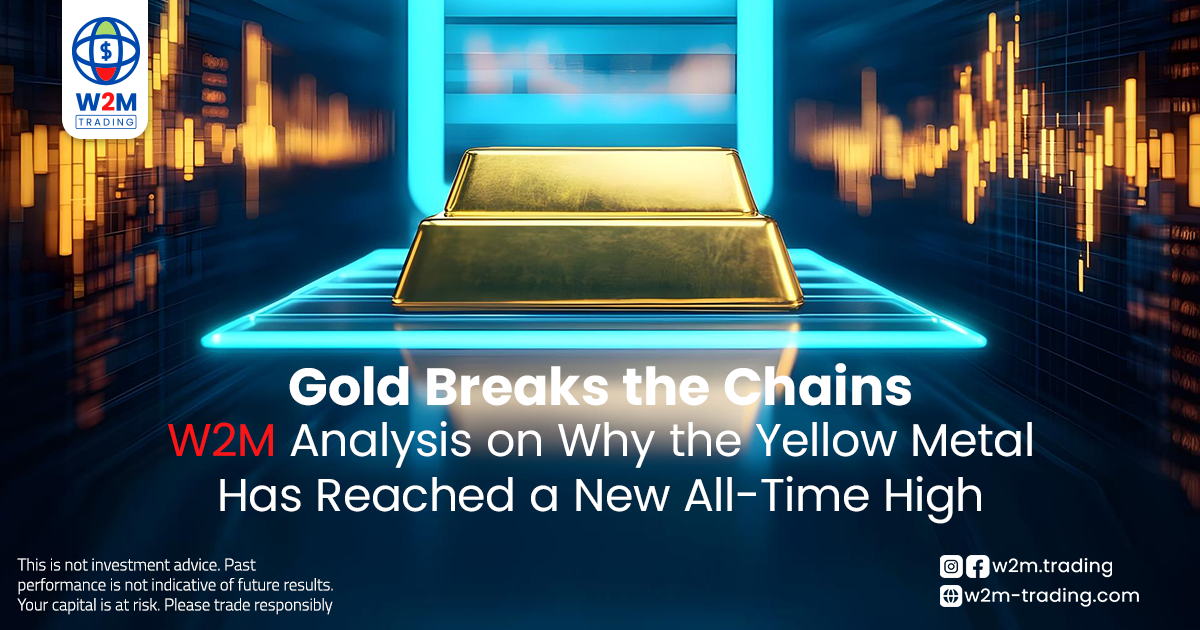- Attractive Education
- Beginner to Advance
- Flexible Timing

Global markets have recently witnessed a historic moment, as gold surpassed its previous record to reach a new peak above $4,300 per ounce. This event is more than just a new number — it’s a clear signal of a deep structural shift in the global financial system.
At W2M, we view gold not merely as a “safe haven,” but as a strategic asset that demands advanced analysis to understand its future trajectory.
Professional traders can summarize the reasons behind this extraordinary surge into three main pillars:
In the past, the U.S. dollar reigned supreme as the world’s reserve currency. Today, that strategic equation is shifting.
Why diversification now? Major nations — particularly in Asia and emerging markets — are increasingly seeking to reduce dependence on fiat currencies that can be subject to sanctions or economic pressures.
Gold as a neutral asset: Gold is the only asset that no government or central bank can print or manipulate. Central banks’ gold purchases represent a strategic move toward “neutralizing” and protecting national wealth.
What it means for traders: Central bank buying creates structural demand, supporting gold’s long-term price and forming a solid foundation for any investment portfolio.
Markets are currently navigating a period of intense geopolitical tension and systemic risk, driving investors toward real safety.
Geopolitical tensions: Ongoing regional conflicts create uncertainty around global trade and supply chains, positioning gold as the primary hedge against instability.
Macroeconomic fears: Rising global debt levels and persistent inflation risks push investors away from assets devalued by money printing — and toward gold as a store of value.
This is the most sensitive factor for traders using fundamental analysis.
The interest rate inverse relationship: When interest rates are high, investors prefer interest-bearing assets like bonds or savings accounts, making gold — which yields no interest — less attractive.
Rate-cut expectations: As markets increasingly anticipate future rate cuts, the “cost” of holding gold decreases, encouraging early buying that fuels price rallies even before the cuts happen.
Alongside these macro factors, several smaller-scale dynamics have accelerated the surge:
Strong consumer demand: Physical gold demand in key markets like China and India remains robust, driven by its traditional role as a savings and investment tool.
Supply constraints: The difficulty of discovering new large gold mines and the rising cost of extraction limit supply growth while demand increases — pushing prices higher.
Speculative momentum: As prices gained momentum, momentum traders and speculators joined in, amplifying the bullish wave.
This record-breaking rally reinforces that gold remains the cornerstone of any well-structured portfolio, especially in an age of uncertainty.
What does this mean for traders?
Gold as a hedge: Treat gold as an essential tool to hedge against U.S. dollar volatility and geopolitical risks.
Focus on real interest rates: Track changes in real interest rates (nominal rates minus inflation) — the lower they fall, the more attractive gold becomes.
Multi-timeframe analysis: Combine fundamental analysis to understand the long-term uptrend with technical analysis to identify ideal entry and exit points for short-term trades.
Join W2M to learn how to integrate both analytical approaches — and turn major global events like this into real trading opportunities in the gold market.
This site is protected by reCAPTCHA and the Google
Privacy Policy and
Terms of Service apply.